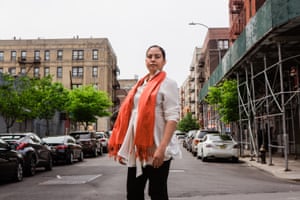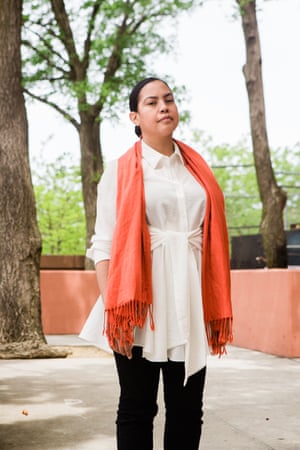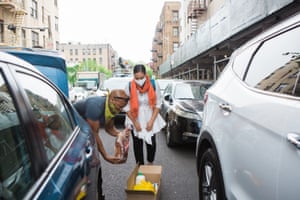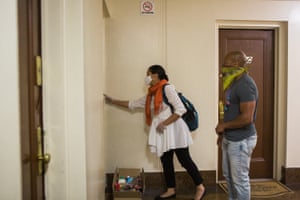Meet Samelys López, the ex-homeless candidate running for New York’s most contested seat
She is backed by Alexandria Ocasio-Cortez and represents a voice much needed in the south Bronx – but can López beat the nine others vying for the seat?

Photograph: Gabriela Bhaskar/The Guardian
The first time Samelys López stood up for an adult she was eight years old. She and her mother were waiting in the welfare office for food stamps when López overheard the case officer speaking down to her mother.
Their lives before they got there hadn’t been easy. López and her mother moved from Puerto Rico when López was a baby, relocating to Williamsburg in New York. Back then, Williamsburg was the most densely populated city in the US: a by-word for poverty rather than trendy coffee shops and vintage boutiques as it is today. It was also host to a fierce sweatshop trade, and López’s family were privy to its harsh hours and low pay.
So López did not like the assumption that her mother was poor because she had not worked hard enough. “I said, you can’t speak to her like that – she is hard-working, she paid into this system,” says Lopez. It was an early lesson to her, that services for poor people can humiliate, rather than help.
That story was one of many that would lead López to where she is today – aged 40, pressed up slightly too close on a Zoom call, from her living room that now doubles up as a campaign office. She is running for Congress in the south Bronx and under usual circumstances, the numbers might be in her favor. The seat is a Democratic stronghold – securing a 94% vote for Hilary Clinton in 2016 – it is the most left-leaning seat in the country. And while López’s humble background might be out of step with many in Congress (she had to give up her own health insurance just to run for office) it is reflective of many lives in the south Bronx, the poorest congressional district in the country. With 98% of its residents being people of color and more than half are 35 – it is fertile ground for a progressive contender.
There’s just one problem: she is running against nine other contenders, many of them former elected officials.
•••
Growing up in New York’s homeless shelter system, López learned a lot. She learned how to dodge the bullies after school, who would follow her back to the shelter she lived in and laugh at her. She learned how to sit quietly in the back of the sweatshop while she did her homework – and as a byproduct of that, that her mother could work incredibly hard and still not be paid enough to afford a babysitter. She learned not to go to the communal bathrooms in her shelter without shoes on – in case there was blood or broken glass on the floor. Ultimately, she was learning that people like her deserved better.

After graduating from Columbia University, López worked for the current incumbent in the south Bronx, congressman José E Serrano. She worked largely on housing cases, but tinkering around the edges while people continuously came back with the same problems frustrated her. She wanted to get involved at an earlier stage – long before people needed bailing out from evictions or were placed in another unaffordable home.
“I wanted to be part of the creative process of building affordable housing, learning about the development process, learning about housing finance. I wanted to be able to say: ‘OK, we need housing – now how do we build it?’” says López.
So López studied for a masters in urban planning – a passion which is made clear when she talks about how buildings, parks or highways can oppress or influence people.
López points to the history of the Bronx as an example of how planning decisions can affect a community forever. Robert Moses’ infamous Cross Bronx Expressway, for example, physically separated the south and the north Bronx, ripping up communities and homes in its path. It brought opportunity for some New Yorkers, but only at the expense of the working-class communities that it destroyed: low house prices as well as poorer life outcomes around that crossway have been blamed on its development.
She talks about the red lines drawn around communities of color in New York, in a time when coveted areas were color coded and graded through a mapping system. The green areas were marked with an “A” if they were were devoid of “a single foreigner or Negro”. Almost all of the south Bronx was coded red. Eventually, federal government lost interest in those areas, and banks deemed them too risky to lend to. Unable to make them profitable again, Landlords disowned their properties in the Bronx. Some even burned down people’s homes for the insurance money.
“The built environment influences your perception of the world and how you see yourself in it. When you see certain things around you, you internalize them – I did when I was growing up. You see cracked bottles and wonder: does this mean I’m not worth it? Am I not deserving of being in this world?” she says.
#CancelRent Samelys López for NY-15🌹 (Bronx)
(@SamelysLopez)As a first-generation formerly homeless Latina, I remember the rent being due & the uncertainty it brought to my life.
That’s why America needs a #HomesGuarantee & why I’m running for Congress.
Watch & RT our video & help bring our movement from BX➡️DC https://t.co/7IDNBaA1oW! pic.twitter.com/IfWEDoKahA
April 1, 2020
So when López was in grad school, she and two colleagues – all women of color who loved cycling – created a program that would take kids from the Bronx on biking trips to educate them about their local surroundings.
“In communities of color that are underserved, we needed to create an avenue for those voices in the community, especially for young people,” says López about the project. They would cycle over to an affordable housing development, to learn about the housing development process, or to a community garden to learn how many local treasures existed there, waiting to be found.
To López’s mind, this was an exercise in redistribution. Planning, architecture, real estate – all are pivotal in deciding what a local area looks like, but they are dominated by white men. Changing the makeup of those professions could play a pivotal role in transforming a community.
“[We want] young people [to] acquire the language of urban planning, understand about the real estate development process, or about advocacy and how to fight for the changes they want to see in their community, on their own terms,” she says.

•••
López is unafraid of her contenders, regardless of their money and clout. Her contenders – who, among others, include Michael Blake, vice-chair of the Democratic National Committee, and New York state senator Rubén Díaz Sr – may have already established themselves politically. But according to López, that’s all the more reason for her to win.
“There are a lot of formerly elected officials running in this race that have taken positions for things like rezoning, that have pushed jail-building, that have a habit of taking lobbyist money and real estate developer money and a history of putting those interests first, before the people,” she tells me.
“What is [their] experience rooted in? Is it rooted in getting you to your career destination? Or was it rooted in transformational justice that is [guided by] your lived experiences and that of your community?” she says.
López has pledged not to take any corporate Pac money during her race, and hopes her platform, which includes fighting for housing as a human right, universal healthcare for all and backing a Green New Deal, will be enough to win over the people of the South Bronx.
If that sounds like a familiar platform it is because it is. López is backed by Bernie Sanders and Alexandria Ocasio-Cortez, as well as having the official backing of Democratic Socialists of America, the group responsible for propelling firebrands such as Rashida Tlaib and Ocasio-Cortez into power. Lopez’s endorsement from Ocasio-Cortez is no small feat: her endorsement was much coveted for the Democratic presidential candidates this year.
Meanwhile, one candidate in the race, Díaz, has branded himself as the “opposite of AOC” – a shot at appealing to voters he believes are tired of increasingly liberal policies in New York. Díaz has name recognition. With a political career in the Bronx stretching back decades, he even has buildings named after him in the area. His homophobia runs back to the 90s, too – as do his extreme stances on abortion. In 2012, in a 1,000-word document he stated: “Hitler was pro-choice. He chose to send the Jews to Auschwitz. That was not their choice that was Hitler’s choice.”
López hopes candidates like Díaz (alongside those she calls “the corporate Democrats”) will split the votes for the centre-ground between them – leaving her with a good chance at winning the remaining progressive votes. That might be a long shot: at present, Díaz is the frontrunner in the race. In June, an independently commissioned poll put him at 22% of the vote, with López trailing behind on 2%, above three other candidates. The poll surveyed just 347 voters – most of which (34%) were still undecided on their vote.
López’s campaign claims the poll was conducted by a Torres ally. Sean McElwee, the head of the company that conducted it, claimed the results meant progressives should back Ritchie Torres, which the poll suggested had the best chance of stopping Diaz Sr. “We must remember that three weeks out from AOC’s 2018 election, Joe Crowley’s polling had him leading by 36 percentage points,” López’s team said.
Galvanizing Bronx voters under the current circumstances could prove tricky. The Bronx has been hit hard by the coronavirus. It leads New York City in terms of Covid-19 cases, hospitalizations and deaths. Locally, it has been referred to as the “death towers”.
New York’s shutdown, which remains firmly in place as select industries reopened, stripped door-knocking, leafletting and local events from López’s campaigning arsenal. That’s a tough sell when you’re trying to build a grassroots movement from the ground up.
But López’s team are quietly assured. She says door-knocking efforts before the pandemic gave her tens of thousands of resident’s details. López has used them to help establish a mutual aid network, checking in on residents, running errands for them and delivering hot meals and groceries.

“We are really proud of [the network we have built] – every time someone needs groceries we put them on a list and we try to get them as quickly as we can – that’s the biggest need right now in the South Bronx,” says López.
She also has hundreds of volunteers at her disposal, phone-banking every week, in shifts of 60-70 volunteers at a time. They claim to be reaching tens of thousands of voters each week, over half of whom are supportive López’s campaign.
So what will she do if she wins it?
“We are experiencing a lot of challenges and I cannot promise that all these things will change overnight. But what I can promise is that the representation [people have] experienced in this community will change,” she says.




